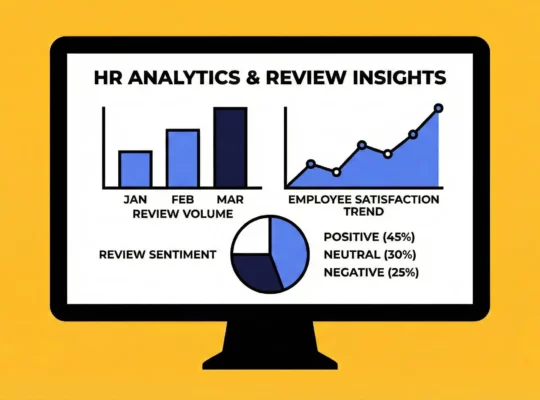Article Summary
Employee engagement committees play a pivotal role in fostering a positive work environment by enhancing motivation, satisfaction, and productivity. This article delves into the importance, structure, responsibilities, and benefits of these committees. It provides practical implementation tips and effective engagement strategies to boost workplace culture. Read on to understand how to measure the success of engagement initiatives and select the right committee members for your organization.
Table of Contents
- The Vital Role of an Employee Engagement Committee in Today’s Workplace
- Definition and Purpose of Employee Engagement Committees
- Importance of Employee Engagement Committees
- Structure of Employee Engagement Committees
- Responsibilities of the Employee Engagement Committee
- Benefits of Employee Engagement Committees
- Implementation Tips for Employee Engagement Committees
- Effective Engagement Strategies
- Measuring the Success of Engagement Initiatives
- Selecting the Right Members for the Committee
- Guidelines for Effective Committees
- Final Thoughts
- FAQs
The Vital Role of an Employee Engagement Committee in Today’s Workplace
Employee engagement is a cornerstone of organizational success, and an employee engagement committee is instrumental in fostering a positive work environment. At Review.jobs, we understand the importance of creating a workplace where employees feel valued, motivated, and committed. Employee engagement committees are dedicated to enhancing job satisfaction, improving retention, and boosting productivity through various initiatives. This article will explore the role, structure, responsibilities, and benefits of employee engagement committees, providing practical tips and strategies for implementation.
Definition and Purpose of Employee Engagement Committees
What is an employee engagement committee?
An employee engagement committee is a group formed within an organization to promote and enhance employee motivation, satisfaction, and productivity. This committee focuses on developing and implementing initiatives that improve the overall work experience and well-being of employees.
Primary objectives and goals
The primary objectives of an employee engagement committee include:
- Improving job satisfaction and employee morale.
- Enhancing workplace productivity and performance.
- Fostering a positive and inclusive company culture.
- Increasing employee retention by addressing engagement challenges.
Differentiation from other employee engagement strategies
While various employee engagement strategies exist, an employee engagement committee stands out by providing a structured, dedicated approach to addressing engagement issues. This committee ensures continuous and systematic efforts toward improving the work environment.
Importance of Employee Engagement Committees
Enhancing motivation and commitment
An employee engagement committee plays a crucial role in enhancing employee motivation and commitment. By actively involving employees in engagement initiatives, the committee helps create a sense of ownership and belonging within the organization.
Impact on productivity, creativity, and retention
Engaged employees are more productive, creative, and likely to stay with the organization. The committee’s efforts in fostering a positive work environment directly contribute to these outcomes, benefiting both employees and the company.
Contribution to an inclusive and supportive work environment
Employee engagement committees promote an inclusive and supportive work environment by ensuring that all voices are heard and valued. This inclusivity helps in building a cohesive and collaborative workplace culture.
Structure of Employee Engagement Committees
Composition of the committee
An effective employee engagement committee comprises representatives from various departments and levels within the organization. This diversity ensures that the committee addresses a wide range of employee needs and perspectives.
Role of diverse representation (employees, HR, management)
Diverse representation is key to the success of an employee engagement committee. Including employees, HR professionals, and management ensures that different viewpoints are considered, leading to more comprehensive and effective engagement initiatives.
Selection process for committee members
Selecting the right members for the committee involves assessing their commitment, passion for employee engagement, and ability to represent diverse perspectives. This process helps in forming a dedicated and effective team.
Responsibilities of the Employee Engagement Committee
Conducting surveys and gathering feedback
One of the primary responsibilities of the employee engagement committee is to conduct regular surveys and gather employee feedback. This data is crucial for identifying areas of improvement and developing targeted engagement strategies.
Developing and implementing engagement initiatives
The committee is responsible for developing and implementing various engagement initiatives, such as recognition programs, wellness activities, and team-building events. These initiatives help in improving employee satisfaction and motivation.
Monitoring and evaluating the effectiveness of strategies
To ensure the success of engagement initiatives, the committee must regularly monitor and evaluate their effectiveness. This involves analyzing feedback, measuring outcomes, and making necessary adjustments to strategies.
Collaborating with other departments
Collaboration with other departments is essential for the committee to implement comprehensive engagement strategies. By working together, the committee can address engagement challenges more effectively and holistically.
Providing a platform for employee concerns and suggestions
The committee serves as a platform for employees to voice their concerns and suggestions. This open communication helps in building trust and ensuring that employees feel valued and heard.
Benefits of Employee Engagement Committees
Improved employee morale and job satisfaction
An active employee engagement committee significantly improves employee morale and job satisfaction by addressing engagement issues and creating a positive work environment.
Increased retention and reduced turnover costs
By enhancing employee engagement, the committee helps in increasing retention and reducing turnover costs. Engaged employees are more likely to stay with the organization, leading to long-term benefits.
Promotion of innovation and creativity
Engaged employees are more innovative and creative. The committee’s efforts in fostering a supportive and inclusive work environment encourage employees to think creatively and contribute new ideas.
Enhanced teamwork, communication, and collaboration
The initiatives developed by the employee engagement committee promote teamwork, communication, and collaboration among employees. This leads to a more cohesive and productive work environment.
Strengthening employee-management relations
By providing a platform for open communication and addressing employee concerns, the committee strengthens relations between employees and management. This trust and transparency are essential for a positive workplace culture.
Boosting employee well-being and overall performance
The committee’s focus on wellness initiatives and engagement strategies directly contributes to employee well-being and overall performance. A healthy and engaged workforce is more productive and satisfied.
Implementation Tips for Employee Engagement Committees
Establishing clear goals and objectives
To ensure the success of the employee engagement committee, it is important to establish clear goals and measurable objectives. This provides a roadmap for the committee’s efforts and helps in tracking progress.
Selecting passionate and committed members
Selecting passionate and committed members is crucial for the effectiveness of the committee. These individuals should have a genuine interest in improving employee engagement and be willing to dedicate time and effort to the cause.
Developing a communication plan
A robust communication plan is essential for keeping all stakeholders informed about the committee’s initiatives and progress. Regular updates and transparent communication help in building trust and support.
Tracking progress and celebrating successes
Tracking progress and celebrating successes are important aspects of maintaining momentum and motivation. Recognizing and rewarding achievements encourages continued effort and engagement from committee members and employees.
Promoting accountability and leveraging technology
Promoting accountability within the committee and leveraging technology for efficient operations are key to success. Clear responsibilities and the use of technology tools help in managing tasks and tracking outcomes effectively.
Effective Engagement Strategies
Recognition programs
Formal recognition programs are essential for celebrating employee achievements and contributions. These programs can include awards, certificates, and public acknowledgment of outstanding performance.
Wellness initiatives
Wellness initiatives promote physical and mental well-being through activities such as fitness challenges, mental health workshops, and wellness days. These initiatives help in improving overall employee health and satisfaction.
Knowledge-sharing sessions
Regular knowledge-sharing sessions provide opportunities for employees to share their expertise and learn from each other. This fosters a culture of continuous learning and professional development.
Diversity and inclusion efforts
Diversity and inclusion efforts, such as training programs and initiatives, create a more inclusive workplace. These efforts ensure that all employees feel valued and respected, regardless of their background.
Mentorship programs
Mentorship programs pair experienced employees with newcomers to provide guidance and support. These programs help in professional development and foster a sense of community within the organization.
Cross-departmental projects
Encouraging cross-departmental projects promotes collaboration and understanding between different teams. This leads to innovative solutions and a more cohesive work environment.
Employee feedback platforms
Efficient employee feedback platforms provide mechanisms for employees to voice their concerns and ideas. These platforms facilitate open communication and help in addressing issues promptly.
Learning and development opportunities
Offering continuous learning programs and career development plans helps employees grow professionally. These opportunities contribute to job satisfaction and long-term career success.
Volunteer and CSR activities
Engaging employees in volunteer and corporate social responsibility (CSR) activities enhances their sense of purpose and connection to the community. These activities also improve the company’s public image.
Flexibility and remote work options
Providing flexible work schedules and remote work opportunities supports a better work-life balance. These options help in accommodating employees’ needs and improving overall satisfaction.
Innovation challenges
Encouraging employees to participate in innovation challenges fosters creativity and problem-solving skills. These challenges can lead to new ideas and improvements within the organization.
Social and team-building activities
Organizing social and team-building activities strengthens relationships and improves morale. These activities help in creating a positive and enjoyable work environment.
Employee surveys
Conducting periodic employee surveys helps in gauging satisfaction and engagement levels. The feedback collected through these surveys is essential for refining engagement strategies.
Measuring the Success of Engagement Initiatives
Continuous evaluation through surveys and feedback
Continuous evaluation of engagement initiatives is crucial for understanding their impact. Regular surveys and feedback help in identifying areas of improvement and making necessary adjustments.
Reporting progress to management and employees
Reporting progress to both management and employees ensures transparency and accountability. Regular updates on the outcomes of engagement initiatives help in maintaining trust and support.
Data-driven decisions for refining strategies
Using data-driven decisions to refine engagement strategies ensures their effectiveness. Analyzing feedback and outcomes helps in making informed adjustments to initiatives.
Selecting the Right Members for the Committee
Criteria for choosing members
Choosing the right members involves assessing their interest in employee engagement, ability to represent diverse perspectives, and commitment to the committee’s goals. These criteria ensure a dedicated and effective team.
Ensuring diverse perspectives
Ensuring diverse perspectives on the committee is essential for addressing a wide range of employee needs and concerns. A diverse committee can develop more comprehensive and inclusive engagement strategies.
Assessing qualifications and commitment
Assessing the qualifications and commitment of potential committee members helps in selecting individuals who are genuinely interested in improving employee engagement and willing to contribute their time and effort.
Guidelines for Effective Committees
Formal establishment and clear objectives
Formally establishing the committee with clear objectives and a defined purpose is essential for its success. This formalization provides a framework for the committee’s efforts and ensures alignment with organizational goals.
Emphasizing confidentiality and compliance
Confidentiality and compliance with laws and regulations are critical for maintaining trust and integrity. The committee must ensure that all discussions and data are handled with confidentiality and in compliance with relevant laws.
Decision-making processes and transparency
Defining the decision-making process and ensuring transparency in all actions are crucial for building trust within the committee and with employees. Clear processes and open communication are key to effective operations.
Providing training and resources
Providing necessary training and resources to committee members is essential for their effectiveness. This support helps members understand their roles and responsibilities and equips them with the tools needed for success.
Avoiding conflicts of interest
Avoiding conflicts of interest and declaring any potential biases is important for maintaining the integrity of the committee. Clear guidelines should be established to manage and resolve any conflicts.
Final Thoughts
Employee engagement committees are essential for creating a motivated, satisfied, and productive workforce. By implementing effective engagement strategies and continuously evaluating their success, these committees can significantly contribute to the overall success and growth of an organization. At Review.jobs, we believe in the power of engagement committees to foster a positive and inclusive work environment. By embracing these practices, organizations can enhance employee well-being and achieve greater organizational success.
FAQs
What is an employee engagement committee?
An employee engagement committee is a group within an organization dedicated to improving employee motivation, satisfaction, and productivity through various initiatives and programs.
Why are employee engagement committees important?
These committees play a crucial role in enhancing job satisfaction, retention, and productivity, while fostering a positive and inclusive work environment.
How do you structure an employee engagement committee?
A well-structured committee includes representatives from various departments and levels within the organization, ensuring diverse perspectives and comprehensive engagement strategies.
What are the primary responsibilities of the committee?
The committee is responsible for conducting surveys, gathering feedback, developing engagement initiatives, monitoring their effectiveness, and providing a platform for employee concerns and suggestions.
What are some effective strategies for boosting employee engagement?
Effective strategies include recognition programs, wellness initiatives, knowledge-sharing sessions, diversity and inclusion efforts, mentorship programs, and flexible work options.
How do you measure the success of engagement initiatives?
Success is measured through continuous evaluation using surveys and feedback, reporting progress to management and employees, and making data-driven decisions to refine strategies.
Who should be on the employee engagement committee?
Committee members should be selected based on their interest in employee engagement, ability to represent diverse perspectives, and commitment to the committee’s goals.
What guidelines should the committee follow?
Guidelines include formal establishment with clear objectives, emphasizing confidentiality and compliance, defining decision-making processes, providing training and resources, and avoiding conflicts of interest.
How can an engagement committee improve employee retention?
By addressing engagement challenges, fostering a positive work environment, and implementing effective engagement strategies, the committee helps in increasing retention and reducing turnover costs.





